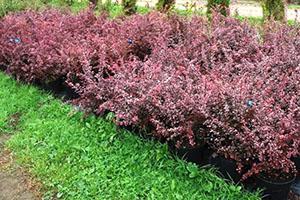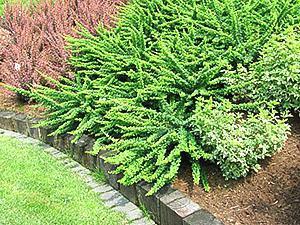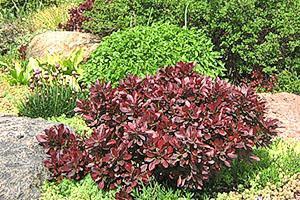Decorative varieties of barberry Thunberg in the design of a summer cottage
 To give the site some attractiveness and originality, the barberry shrub is often used in landscape design. An ornamental plant is valued for the fact that its appearance is constantly changing throughout the year. This brings a certain variety to landscape compositions.
To give the site some attractiveness and originality, the barberry shrub is often used in landscape design. An ornamental plant is valued for the fact that its appearance is constantly changing throughout the year. This brings a certain variety to landscape compositions.
One of the most spectacular and popular shrub species is the Thunberg barberry (Berberis thunbergii). Its homeland is the Far East, where the shrub grows on rocky mountain slopes. And since 1864, it has been cultivated practically throughout Russia.
General characteristics of Thunberg barberry varieties

- Atropurpurea Nana;
- Golden Ring;
- Aurea;
- Bagatelle;
- Green Carpet;
- Kobold.
This type of barberry, depending on the variety, has green, yellow or purple foliage and arched branches with thin single spines. Its flowering period lasts from May to June. The fruits ripen in autumn and often do not fall off until the end of winter.
Thunberg barberry varieties are quite unpretentious in terms of soil, they tolerate heat and drought well. However, they grow poorly in wetlands and where groundwater is nearby. This type of barberry is grown in sunlit places, and some varieties in partial shade. The shrub easily recovers after frost, but it is advisable to cover young plants for the winter. One of the advantages of the species is resistance to fungal diseases.
Typically, varieties of barberry Thunberg are used in gardens and parks as hedges and borders for zoning the territory, for creating decorative groups and in single plantings. This type of barberry is great for creatingJapanese garden and is also used to anchor the banks of irrigation systems.
Barberry Thunberg Atropurpurea Nana
 Red-leaved variety, dwarf form of barberry Atropurpurea. Main characteristics:
Red-leaved variety, dwarf form of barberry Atropurpurea. Main characteristics:
- adult bushes grow about 61 cm high and no more than 91 cm wide, the crown is compact, cushion-shaped;
- in the summer, the foliage has a purple color; with the arrival of autumn, it changes its color and becomes bright red;
- in spring (April - May) the barberry of Thunberg Atropurpurea Nana is hung with small yellow flowers;
- fruits are deep red, glossy, ripen in October and remain on the branches even in winter;
- good frost resistance;
- loves a sunny location;
- It is commonly used in single plantings, decorative bands, rockeries and to create curbs.
For planting, it is recommended to purchase acclimatized barberry seedlings of Thunberg Atropurpurea Nana, grown in a plastic container along with fertilizers. Because in the process of digging a seedling out of the ground, damage to the roots is possible, which can negatively affect the further development of the plant.
Barberry Thunberg Golden Ring
 Tall variety with a unique color. Main characteristics:
Tall variety with a unique color. Main characteristics:
- in height and width the bush reaches 2-3 m, the crown is branched, spreading;
- foliage of a dark purple color has a thin yellow-green border, and with the arrival of autumn, the leaves become rich red;
- in spring (in May), the Golden Ring Thunberg barberry is decorated with small yellow inflorescences;
- fruits are coral-red, glossy, ripen in October;
- winter hardiness of the variety is high;
- grows well in areas illuminated by the sun, and the decorative effect of the leaf disappears in the shade;
- great for landscape compositions, hedges, and also used as a tapeworm, shears well.
Barberry Thunberg Golden Ring is prone to defeat by barberry aphids. To prevent the bushes from damage, in the spring it is necessary to carry out preventive spraying of plants with insecticides.
Barberry Thunberg Aurea
 Low-growing yellow-leaved variety of barberry. Main characteristics:
Low-growing yellow-leaved variety of barberry. Main characteristics:
- the bushes grow up to 0.8 m in height and 1 m in width, the crown is compact, round;
- the variety is characterized by yellow foliage with a soft golden tint, with the arrival of autumn it becomes yellowish-orange in color;
- bloom barberry Thunberg Aurea begins in May, flowers are golden yellow, collected in neat inflorescences;
- fruits of deep red color, ripen in September and stay on the branches all winter;
- has good frost resistance;
- the foliage of the shrub quickly dries up and falls off under the influence of direct sunlight, and in the shade the color of the leaves becomes light green, so it is recommended to plant it in partial shade;
- used in single plantings and decorative groups, to create borders and hedges.
Barberry Thunberg Aurea can be planted near dark junipers and blue spruces. Thanks to the original bright yellow color of the foliage, it will look impressive against this background.
Barberry Thunberg Bagatelle
 Ornamental dwarf shrub. Main characteristics:
Ornamental dwarf shrub. Main characteristics:
- bush with a height and crown diameter of a maximum of 40 cm, the crown is dense, pillow-shaped;
- in summer, the leaves are crimson-red, in autumn they become bright red;
- barberry Thunberg Bagatelle begins to bloom in May, flowers are white, sometimes with a yellowish tinge;
- fruits are deep red, ripen in October and last throughout the winter;
- has good winter hardiness;
- the variety is photophilous and drought resistant;
- used to create miniature borders, decoration alpine slides, balconies and terraces, looks great in all flower beds.
If this variety is planted in the shade, it may lose its original leaf color and turn greenish. Therefore, for a more intense color, it is advisable to plant the Thunberg Bagatelle barberry in the sun.
Barberry Thunberg Green Carpet
 Medium-sized Dutch variety. Main characteristics:
Medium-sized Dutch variety. Main characteristics:
- the bushes grow up to 1 m in height, the crown diameter is 1.5 m, the crown is compact, rounded;
- in summer, foliage is light green, with the arrival of autumn it becomes bright red;
- the flowering of the Barberry Thunberg Green Carpet begins in May, the flowers are yellow, collected in small clusters;
- fruits are glossy, coral in color, ripen in September;
- good frost resistance;
- location in the sun is recommended, does not like shade, heat and drought resistant;
- the variety looks great in combination with deciduous and coniferous shrubs with different colors and crown shapes, is used in single, group plantings and as a ground cover plant.
It is recommended to plant the Thunberg Green Carpet barberry in spring or autumn. If the planting is single, then the gap between the bushes should be at least 1.5 m. And when creating a hedge, you need to dig a trench and arrange the plants, 2 bushes per 1 linear meter. m.
Barberry Thunberg Kobold
 Low-growing densely branched variety. Main characteristics:
Low-growing densely branched variety. Main characteristics:
- the height of the bush and the diameter of the crown do not exceed 50 cm, the crown is cushion-shaped, compact;
- in the summer, the foliage is dark green, with the arrival of autumn it turns into golden yellow or bright red;
- flowering of barberry Thunberg Kobold begins in May, yellow flowers are collected in neat inflorescences;
- the fruits are glossy, pink or red, ripen in September;
- good winter hardiness;
- photophilous, does not like shadow;
- it is used in group plantings, garden and park tree and shrub compositions, to create borders and design alpine slides, lends itself well to cutting and pruning.
In the second year after planting, the Thunberg barberry Kobold is recommended to be fed with nitrogen fertilizers. Subsequent feeding is carried out every 3-4 years.
With the help of barberry bushes, you can create interesting and unique landscape compositions. A large number of different varieties of Thunberg barberry allows you to choose the right foliage color and the required height. And simple agricultural technology makes it possible to take care of the bush easily and with pleasure.